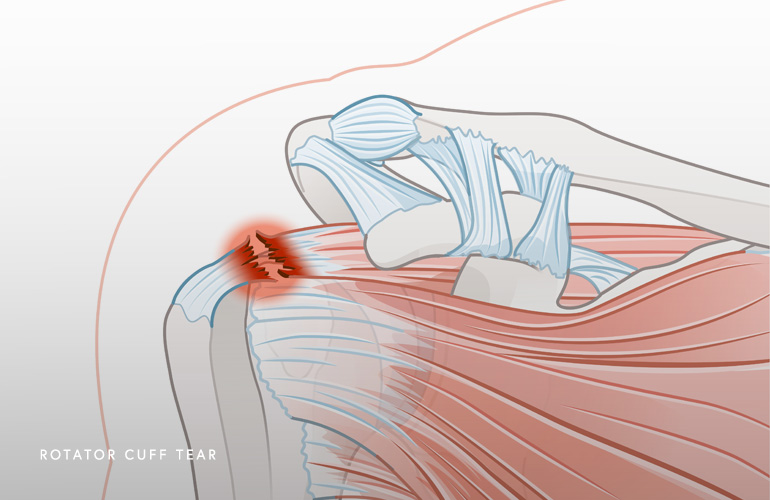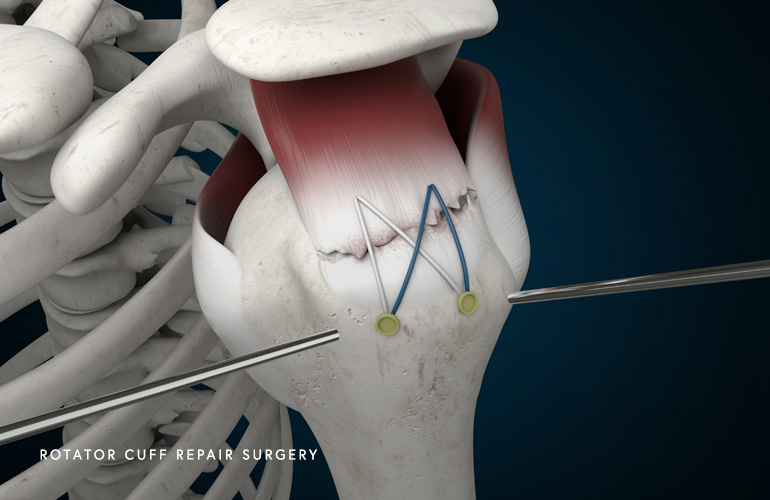Rotator Cuff Tear
Anatomy of the Rotator Cuff
The shoulder is a ball and socket joint between upper humerus (ball) and scapula (called the glenoid socket). Because the socket is not a full cup and just a shallow dish similar to the depression of a golf tee, it requires a large tendon called the rotator cuff to hold the ball in position. This rotator cuff tendon wraps around the ball and pulls and compresses it into the socket to hold it in place so that the ball can rotate and lift the arm via the other powerful shoulder muscle called the deltoid.
The “rotator cuff” is actually comprised of four separate muscles originating at different places around the scapula (shoulder blade). These four muscles are the supraspinatus, infraspinatus, subscapularis and teres minor. These muscle form tendons near the humerus ball and the tendons coalesce to form what is known as the rotator cuff tendon which wraps around the humerus like a glove. This rotator cuff glove holds the humerus compressed into the glenoid socket while the deltoid powers the arm around for activity, much like the fulcrum of a lever.
There are two primary causes of rotator cuff tears, trauma and degeneration (also known as wear and tear). The “degenerative” tears of the rotator cuff are much more common than traumatic ones. Degenerative tears typically occur over time where the rotator cuff tendon building blocks called collagen break down and leave the tendon susceptible to pulling from the insertion site on the humerus. This process is amplified and accelerated by bone spurs that develop from a “roof” bone on the scapula called the acromion. There may be genetic determinants of rotator cuff degeneration that are being actively investigated. There are sometimes familial patterns of rotator cuff tears and we know that if you have been diagnosed with a tear on one shoulder, you are more susceptible to developing a tear on the other one.
As mentioned, the bone spur formation from the acromion is highly correlated with the development of rotator cuff tears. The acromion bone itself has variations in the way it is formed and some individuals have a more down-sloped acromion bone that is more likely to pinch and rub on the rotator cuff. To make matters worse, patients with down-sloping acromions can then form spurs on top of their inborn anatomy, making them much more likely to develop a tear as they age.
For most patients diagnosed with a rotator cuff tear, the tearing process is a combination of age-related degeneration of the tissue as well as a bone spur-related pinching and rubbing process from the acromion. Once the rotator cuff tears, it cannot heal itself. Some of these tears can get worse as you age, and as the tear worsens, it gets larger, and the tissue can further deteriorate and become more difficult to treat.
The symptoms of a rotator cuff tear are shoulder pain, experienced with gentle or forceful activities of the arm, and sometimes at night as the tear is starting to enlarge. As the tear gets worse, range of motion and strength become impaired. Patients may note that activities that were previously painless are becoming sore and difficult such as reaching a cupboard, throwing a ball, or swinging a golf club. When the tear gets substantially large, patients can lose the ability to lift the arm, which can be very disabling.
As mentioned previously, rotator cuff tears can occur from a traumatic injury. Sometimes this can happen from a fall, a sudden lifting motion, or a jerking motion from a load applied to the arm. This can happen at the workplace when there is a force through the arm as with catching a large object or holding oneself up after slipping. Sometimes a direct blow to the side of the shoulder can cause a rotator cuff tear. When these traumatic tears occur, they typically hurt shoulder after the injury and continue to cause discomfort with use. These tears are important to have evaluated because they can continue to cause pain and weakness and are at risk of worsening with time.

The treatment of rotator cuff tears depends on the location, chronicity (how long it has been there), and size of the tear. Degenerative type tears, especially when caught early, can sometimes be treated with a course of strengthening and physicial therapy where the rotator cuff and shoulder blade muscles are strengthened. Sometimes cortisone injections help temporarily reduce pain and improve motion so the tear can be more effectively rehabilitated. Other experimental biologic injections have been shown to improve inflammation, or the body’s reaction to the tear. When this fails, or the tear is highly susceptible to enlarge, or is located at a position likely to cause weakness and functional difficulties for the patient, sometimes minimally invasive pokehole surgery (arthroscopy) is used to repair the tear. As noted previously, traumatic tears from a fall or injury are often more likely to cause long term problems for the patient and sometimes are best managed with arthroscopic repair.
The surgery for rotator cuff tears involves arthroscopy. While some shoulder surgeons use the “scope” to diagnose the tear and then open the shoulder to repair the tendon, Dr. Obermeyer repairs all rotator cuff tears completely arthroscopically. This lessens healing time, lessens pain and the risk of infection, and is equally or more effective in treating larger tears.
Arthroscopic rotator cuff repair is completed through tiny poke-holes in the shoulder and is completed with sutures and anchors. The anchors are a biocompatible plastic and screw into the bone of the humerus and the sutures are used to strategically sew the tendon back onto the bone where it belongs. Shoulder surgeon Dr. Obermeyer uses the most secure and cutting edge technique to repair the rotator cuff called a “double row” technique where there are two rows of anchors, ensuring the tendon heals and almost universally eliminates the need for revision surgery or a chance of an unhealed tendon.

Schedule an orthopedic appointment
If you have pain in your shoulder and are concerned you may require an orthopedic subspecialist evaluation, call our office, or book an appointment with shoulder surgeon Dr. Thomas Obermeyer. Dr. Obermeyer provides expert orthopedic care for patients suffering from a Rotator Cuff Tear. Dr. Obermeyer has orthopedic offices in Schaumburg, Bartlett, and Elk Grove Village, Illinois. Dr. Obermeyer regularly sees patients from throughout Illinois including Hoffman Estates, Palatine, Elgin, Streamwood, Arlington Heights, and Roselle communities.
At a Glance
Dr. Thomas Obermeyer
- 15+ years of training and experience treating complex shoulder and sports medicine conditions
- Expert subspecialized and board-certified orthopedic care
- Award-winning outstanding patient satisfaction scores
- Learn more

